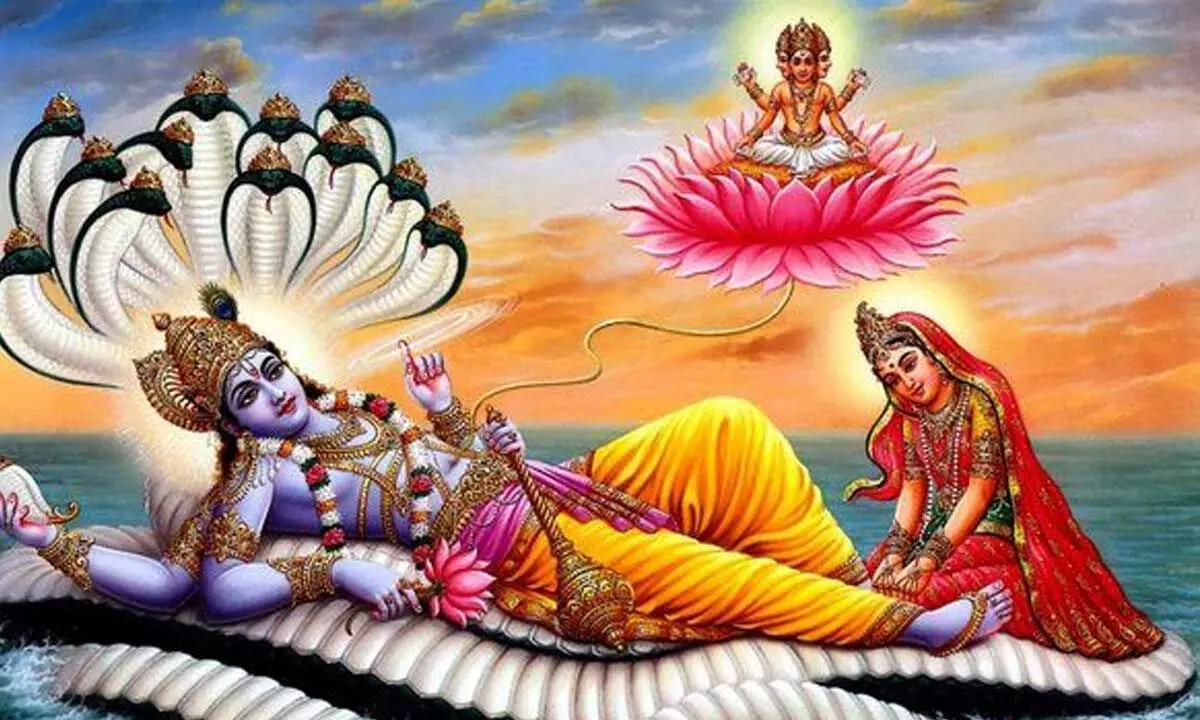Live
- President Droupadi Murmu Arrives in Hyderabad to Attend Koti Deepotsavam
- Border-Gavaskar Trophy 2024-25: Rohit Sharma to join Indian team midway of Perth Test, set to be available from second Ind vs Aus Test
- Scholarships For Students
- EFLU hosts talk on 75 years of the Indian Constitution
- Mohan Babu: Half a Century of Cinematic Brilliance and Unwavering Legacy
- Chandrababu Vows Strict Measures for Women's Safety and Drug Control
- Deputy CM Bhatti Vikramarka Highlights Congress Government's Achievements
- PCC Expansive Meeting Held at Gandhi Bhavan in Hyderabad
- Formula 1: I didn't really want to come back after Brazilian GP, admits Hamilton
- IND vs AUS BGT 2024-25: Pat Cummins says the pressure of playing at home is there but team well prepared to beat India and win Border-Gavaskar Trophy
Just In

Are the puranas to be taken as literal truth? Not necessarily.
Are the puranas to be taken as literal truth? Not necessarily. The stories of gods and demons are to be taken at the symbolic level. For instance, a story such as Brahma being born from the lotus sprung from the navel of Vishnu, or Vishnu going as Vamana and subduing the asura king Bali, Vishnu saving the king of elephants, or Krishna humbling the vicious serpent, are clearly symbolic stories. A parent must remember that one should not venture to explain such stories without proper knowledge of philosophy. Intelligent parents are taking their kids to Vedanta camps by modern teachers. This puts the stories in their proper place. Otherwise, modern kids can develop wrong ideas or get carried away by wrong narratives. Our kids are making us know what we failed to know earlier.
Most of us do not know much about the Gita or the Upanishads but know a lot of stories from the puranas. We wish to train our children in Hinduism and buy books like Amar Chitra Katha and such others. They create a lot of awareness about gods, goddesses, puranic heroes like Arjuna, Bhima, Hanuman and others. We get a feeling that we know all about Hinduism, but at some time the parent realizes that he has to know something more. The multitude of stories present a confusing picture, and the parent has to resolve the puzzles and explain the meaning of stories to kids.
In some of the earlier episodes we saw some stories from puranas and noted that the person interpreting them should have some knowledge of the unity of thought in our scriptures. The Vedic seers were from different places of the ancient Bharat varsha which extended much beyond the present boundaries of India. They had their congregations or seminars when a king performed some yagna or when some special discussions and debates were organized as we see in the court of King Janaka in the Brihadaranyaka Upanishad. A series of debates can be seen in that Upanishad. There were women debaters, known as brahma-vadinis, who debated on the nature of Brahman with eminent sages like Yajnavalkya. This labyrinth of discussions was sorted out by a great sage Badarayana, who established a unity of thought in the Upanishadic debates. We have clarity about the nature of brahman, jiva and the universe.
Can we see such unity of thought in the puranas? Unfortunately, no. Tradition holds that they were all written by sage Vyasa, but one purana says that the ten avatars of Vishnu emanated from the fingernails of goddess Lalita. Another one says that Vishnu is the ultimate and Shakti is his sister. One text says that Shiva is the father of Brahma, and another text says that Shiva is the son of Brahma. Different texts have different hierarchies. One text says that Shiva is a great devotee of Vishnu, and another says exactly the opposite, that Vishnu is a devotee of Shiva. The symbolism of the same story may vary from one text to another. Some scholars however say that this was deliberately written so by sage Vyasa to tell us not to see the difference in names and forms because the truth is the impersonal Brahman. However, many scholars disagree with the idea that they were all by one person. They say that the texts were written by scholars of different traditions. A modern parent has a tough time explaining this puzzle to his globalized child. Our comic classics can rightly compound the confusion.
Puranas also give some details of our ancient history, not in a chronological order, but by way of moral illustrations. Thus, kings such as Prithu, Harishchandra, Nala and many others are real characters, as they are found in several texts, but their stories are presented to highlight certain virtues which they exemplify. The stories also tell about migration of clans beyond Bharat varsha, describe our historical cities, different clans of kings and regional cultures. They also demonstrate the cultural unity of the then Bharat varsha. These are the subject of study for several Indologists now and hence we cannot ignore their study.
The writer is a former
DGP, Andhra Pradesh)

© 2024 Hyderabad Media House Limited/The Hans India. All rights reserved. Powered by hocalwire.com







